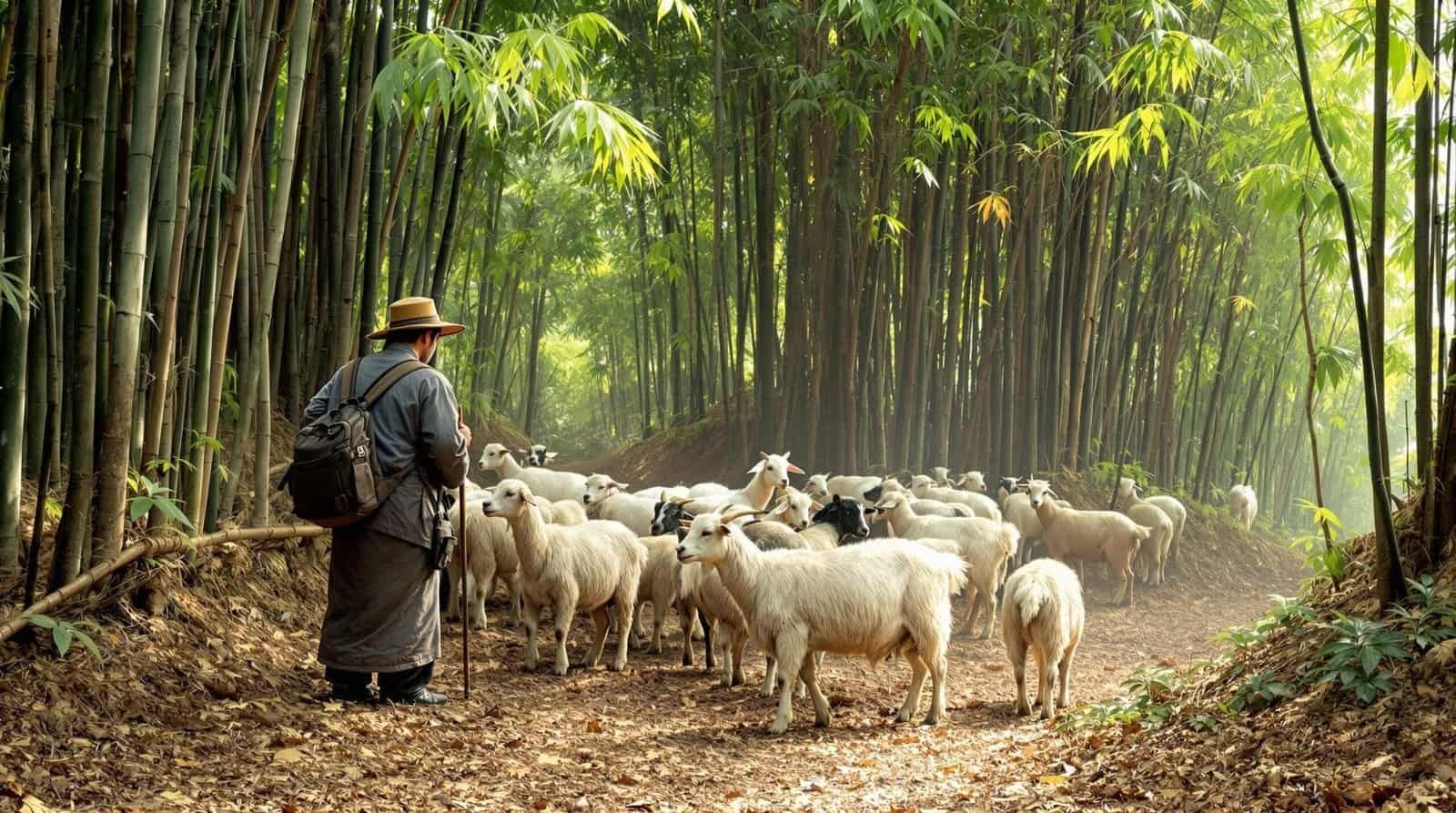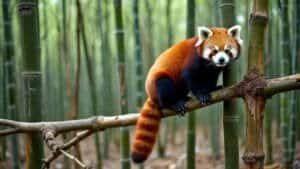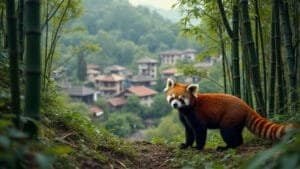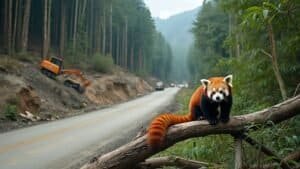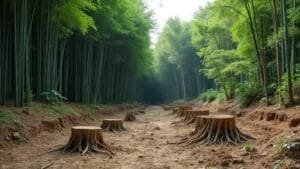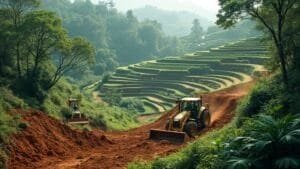Livestock grazing poses significant challenges to the delicate balance of red panda habitats. These elusive creatures rely on dense bamboo forests in the Himalayan region, but the encroachment of grazing animals disrupts their ecosystem in multiple ways. From reduced bamboo availability to fragmented habitats, grazing has far-reaching consequences for red panda populations
This article explores how grazing impacts bamboo regeneration, alters forest composition, and increases competition for resources. Additionally, it examines how human activities and habitat disturbances affect red panda behavior and reproduction, while highlighting sustainable practices that can help conserve their environment
The Effects of Livestock Grazing on Red Panda Habitats
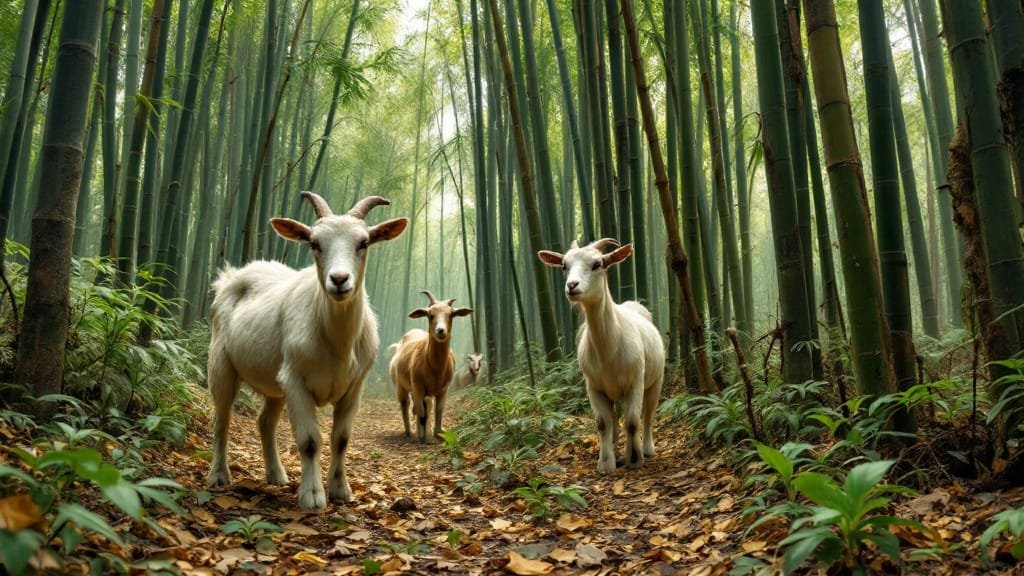
Livestock grazing has profound effects on the habitats of red pandas, particularly in the Himalayan region. These ecosystems, characterized by dense bamboo forests, are vital for the survival of red pandas
However, grazing pressures not only degrade these habitats but also introduce competition for resources, leaving red pandas struggling to adapt. Below, we explore specific ways in which grazing impacts bamboo availability, forest composition, and resource competition
How Livestock Grazing Reduces Bamboo Availability
Red pandas depend on bamboo for 95% of their diet, making it an irreplaceable resource in their habitat. However, livestock such as yaks and cattle consume large quantities of bamboo during grazing. According to a 2015 study, livestock grazing in Nepal has led to a significant decline in bamboo density, leaving red pandas with limited feeding options
Additionally, young bamboo shoots, which are essential for red panda nutrition, are often trampled by grazing animals, preventing their regeneration. Over time, this leads to an overall depletion of bamboo in affected areas, forcing red pandas to move to less suitable regions where food availability is scarce
Research conducted in 2020 highlights that in heavily grazed regions, bamboo availability decreases by nearly 40%, directly impacting red panda populations. This shortage not only compromises their nutrition but also reduces their chances of successful reproduction, as bamboo is crucial for sustaining energy during mating and rearing offspring
Impact of Overgrazing on Forest Composition and Soil
Livestock grazing alters forest ecosystems by degrading the vegetation structure and compacting the soil. Forests with high grazing activity experience a loss of understory vegetation, which is essential for providing shelter and feeding grounds for red pandas
A study from 2012 noted that overgrazed areas in Bhutan showed a marked decline in bamboo cover and increased soil erosion. These changes diminish the forest’s ability to regenerate and create an inhospitable environment for red pandas
Soil compaction caused by grazing animals prevents water infiltration, further hindering bamboo growth. Over time, these effects accumulate, leading to barren patches of land within red panda habitats. The combination of reduced vegetation and degraded soil disrupts the delicate balance of these ecosystems, making them less capable of supporting wildlife
Competition for Resources Between Livestock and Wildlife
Livestock and red pandas compete for the same limited resources, primarily bamboo and other vegetation. As livestock populations grow, the pressure on these shared resources intensifies
Research from 1991 found that in areas with high grazing density, red panda populations declined by nearly 50% due to competition for bamboo. This competition is particularly severe during winter months when bamboo is already scarce
Additionally, the movement of herders and livestock through red panda habitats increases disturbance levels, forcing the pandas to retreat to less optimal areas. These disturbances disrupt natural feeding patterns and lead to increased energy expenditure, further compromising red panda survival. Without adequate intervention, this competition could drive red pandas out of their traditional habitats, leading to population declines
Habitat Fragmentation and Its Consequences for Red Pandas

Red pandas are highly dependent on contiguous forested areas for their survival. However, livestock grazing and associated human activities lead to habitat fragmentation, disrupting their movement, feeding, and breeding patterns. Fragmented habitats not only reduce the area available for red pandas but also isolate populations, making them more vulnerable to extinction
In this section, we delve into the causes of habitat fragmentation, its effects on red panda populations, and conservation measures aimed at mitigating these challenges
Causes of Habitat Fragmentation in Red Panda Regions
Livestock grazing is one of the leading causes of habitat fragmentation in red panda regions. As grazing areas expand, they create gaps in forests that were once continuous. Trails used by livestock and herders exacerbate fragmentation by breaking up large forested areas into smaller, isolated patches. Over time, this process leads to the division of habitats that red pandas rely on for food, shelter, and reproduction
Studies conducted in Nepal have shown that overgrazing creates fragmented landscapes, reducing forest cover by nearly 25% in heavily grazed areas. Additionally, human activities such as logging and agricultural expansion further contribute to habitat loss. These combined factors disrupt the connectivity of forest corridors, which are essential for red pandas to move between feeding and resting areas
Effects of Fragmentation on Red Panda Movement and Breeding
Habitat fragmentation forces red pandas to traverse open, degraded areas, increasing their exposure to predators and environmental stress. A study found that fragmented habitats significantly limit the movement of red pandas, reducing their ability to find food and mates. This isolation often results in smaller, inbred populations, which are more susceptible to diseases and genetic defects
Fragmentation also disrupts red panda breeding cycles. Red pandas prefer dense, undisturbed forests for nesting, and fragmented areas rarely meet these criteria. Without access to suitable nesting sites, reproductive success declines, further jeopardizing red panda populations. Research highlights that fragmented habitats led to a 30% reduction in red panda reproductive rates, emphasizing the importance of maintaining contiguous forests
Mitigating Fragmentation Through Conservation Efforts
Conservation initiatives aimed at reducing habitat fragmentation focus on protecting existing forests and restoring degraded areas. Protected areas such as national parks and wildlife corridors are crucial for maintaining connectivity between red panda habitats. For example, Bhutan’s network of biological corridors has been successful in linking fragmented forests, allowing red pandas to move freely across their range
Community involvement is also key to addressing habitat fragmentation. Programs that promote sustainable grazing practices and alternative livelihoods for herders can reduce the pressure on forest ecosystems. Additionally, reforestation projects that prioritize native bamboo species help restore red panda habitats and create continuous forested areas
Research suggests that by integrating conservation efforts with local community needs, it is possible to mitigate the impact of grazing and ensure the long-term survival of red pandas in their natural habitats
Long-Term Impacts of Grazing on Bamboo Regeneration
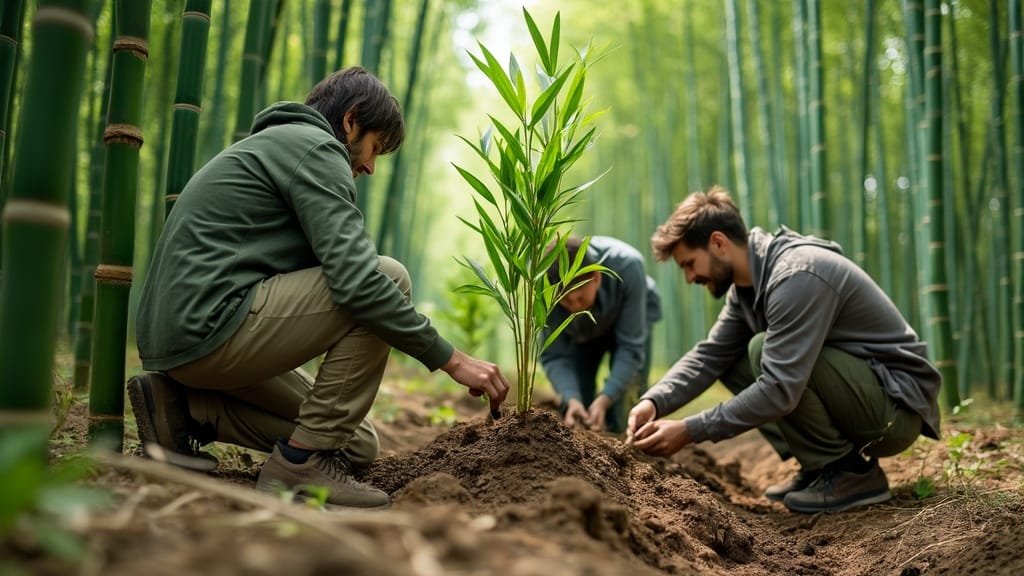
Bamboo is the cornerstone of red panda diets, yet its sustainability is under threat due to the long-term impacts of grazing. Overgrazing by livestock hinders bamboo regeneration, leading to a decline in bamboo forests that red pandas rely on for food and shelter
This section explores how grazing prevents bamboo growth, the consequences for red panda food sources, and the importance of implementing sustainable solutions to protect bamboo ecosystems
How Overgrazing Prevents Bamboo Growth
Overgrazing significantly affects the natural growth cycle of bamboo, primarily by trampling young shoots and compacting soil. Bamboo regeneration depends on the survival of seedlings, which grazing animals frequently consume or destroy. Studies have shown that in heavily grazed areas, bamboo seedling survival rates are reduced by over 50%, limiting the replenishment of bamboo populations.
In addition to direct damage caused by grazing, soil compaction from livestock hooves inhibits root penetration and water infiltration. This makes it challenging for bamboo plants to establish and grow, particularly in areas with already fragile ecosystems. Research conducted in Bhutan noted that overgrazed regions saw a drastic decline in bamboo density, with some areas losing up to 40% of their bamboo cover over a decade
Effects on Red Panda Food Sources Over Time
As bamboo forests dwindle due to grazing, red pandas face increasing difficulties in finding sufficient food. Bamboo constitutes the majority of a red panda’s diet, and its decline leads to malnutrition and weakened immune systems. Studies have highlighted that red panda populations in heavily grazed regions show decreased body weights and reduced reproductive success, signaling the cascading effects of food scarcity
Additionally, the loss of bamboo forces red pandas to migrate to less suitable habitats, where food may be even scarcer. This not only increases their exposure to predators but also heightens competition with other wildlife for limited resources. Over time, the combination of poor nutrition and increased risks in degraded habitats contributes to declining red panda populations
Sustainable Solutions to Protect Bamboo Forests
Addressing the long-term impacts of grazing requires sustainable grazing practices that balance the needs of livestock with the preservation of bamboo ecosystems. Rotational grazing systems, which allow bamboo forests time to recover between grazing periods, have shown promise in reducing habitat degradation. Limiting livestock numbers in red panda habitats can also help alleviate pressure on bamboo resources
Reforestation efforts focusing on native bamboo species are essential for restoring degraded habitats. In Nepal, community-led initiatives have successfully planted bamboo in overgrazed areas, creating new feeding grounds for red pandas. These efforts also provide economic benefits to local communities through sustainable bamboo harvesting programs
Education and awareness campaigns are critical for encouraging herders to adopt sustainable practices. By highlighting the importance of red pandas as flagship species for conservation, these programs foster a sense of shared responsibility among local populations. Combined with government policies and conservation funding, these solutions can help ensure the long-term sustainability of bamboo forests and the survival of red pandas
Human Activities and Red Panda Habitat Degradation
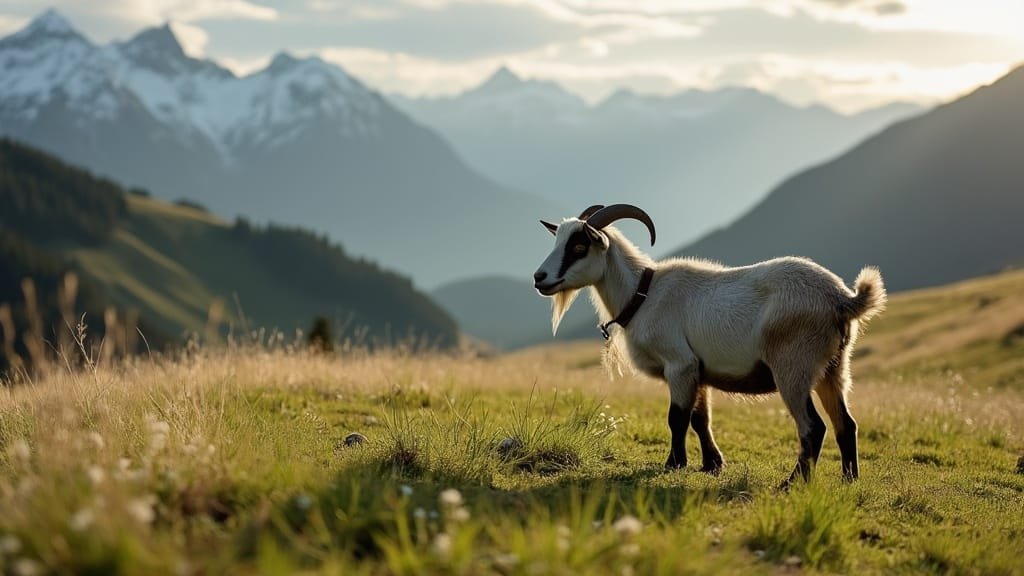
Human activities, including livestock grazing, logging, and agriculture, are among the primary causes of habitat degradation in regions inhabited by red pandas. These activities not only diminish the quality of their habitats but also disrupt their natural behaviors, increasing their vulnerability to environmental and human-induced threats
This section explores the role of grazing and other anthropogenic pressures in habitat loss, the challenges they pose, and community-based conservation strategies to address these issues
Livestock Grazing and Its Role in Habitat Loss
Livestock grazing is a major contributor to the degradation of red panda habitats. As grazing areas expand, forests are cleared to make room for livestock, leading to a decline in bamboo forests and other vegetation essential for red pandas. A study found that regions with high grazing intensity experienced a 25% loss in forest cover, leaving fragmented and degraded habitats unsuitable for wildlife
In addition to direct habitat destruction, grazing introduces disturbances that disrupt the red panda’s natural behavior. The movement of livestock and herders through forested areas increases noise and activity, making it difficult for red pandas to rest and forage. These disturbances force red pandas into suboptimal habitats, where food is scarce, and predation risks are higher
Other Anthropogenic Threats to Red Panda Habitats
Apart from grazing, human activities such as logging and agriculture significantly contribute to the loss of red panda habitats. Unsustainable logging practices reduce the availability of mature trees, which are critical for providing shelter and nesting sites for red pandas. Additionally, agricultural expansion into forested areas leads to the fragmentation and destruction of bamboo forests
Tourism and infrastructure development, including roads and trails, further exacerbate habitat degradation. While tourism can bring economic benefits, poorly managed activities can lead to increased litter, soil erosion, and disturbance to wildlife. Studies have highlighted that human encroachment, even in protected areas, has a direct negative impact on red panda populations by reducing the quality and availability of their habitats
Community-Based Conservation and Sustainable Practices
Community involvement is a vital component in addressing the degradation of red panda habitats. Conservation programs that engage local populations in sustainable practices not only protect biodiversity but also improve livelihoods. For example, initiatives that promote rotational grazing systems or provide alternative income sources, such as ecotourism, can reduce the reliance on forest resources
In regions like Nepal and Bhutan, community-led anti-poaching patrols and habitat restoration projects have proven effective in protecting red panda populations. These programs also raise awareness about the ecological importance of red pandas and the need for sustainable land use
Furthermore, integrating traditional ecological knowledge with modern conservation science has helped develop context-specific solutions for habitat preservation. For example, local communities have successfully adopted agroforestry techniques that incorporate bamboo planting alongside agricultural crops, balancing economic needs with ecological conservation
By fostering collaboration between governments, conservation organizations, and local communities, it is possible to mitigate the impact of human activities on red panda habitats and ensure the long-term survival of these endangered animals
Behavioral and Reproductive Effects on Red Pandas

The degradation of red panda habitats caused by livestock grazing and other human activities has significant consequences for their behavior and reproductive success. Habitat disturbances force red pandas to adapt to less suitable environments, disrupting their feeding, nesting, and mating patterns
In this section, we examine how habitat disturbances affect red panda behavior, the role of stress in their reproduction, and measures to protect their habitats to ensure their survival
How Habitat Disturbance Impacts Red Panda Behavior
Red pandas are highly sensitive to changes in their environment. Disturbances caused by livestock grazing, such as noise, trampling, and human presence, interfere with their natural behaviors, particularly resting and feeding. A study observed that red pandas in disturbed areas spent up to 30% less time resting compared to those in undisturbed habitats. This increased activity level depletes their energy reserves, making it harder for them to maintain their health and reproductive capabilities
In addition, disturbances force red pandas to alter their movement patterns. Instead of foraging in optimal feeding areas, they are often pushed into suboptimal habitats with limited bamboo availability. This displacement not only reduces their nutritional intake but also exposes them to higher risks of predation. Over time, these behavioral changes can lead to declines in population numbers and overall fitness
Stress and Its Role in Reproductive Success
Stress induced by habitat degradation and disturbances has a profound impact on red panda reproduction. Research found that red pandas exposed to frequent disturbances exhibited elevated cortisol levels, a hormone associated with stress. High cortisol levels are known to suppress reproductive functions, reducing the likelihood of successful mating and pregnancy
Habitat disturbances also impact the availability of suitable nesting sites, which are critical for reproduction. Female red pandas typically seek out dense, undisturbed forests to give birth and rear their cubs. When these areas are degraded, they may fail to find adequate shelter, leading to lower survival rates for their offspring. A study highlighted a 25% decline in red panda reproductive success in heavily disturbed habitats compared to protected areas
Protecting Red Panda Habitats to Ensure Survival
Protecting red panda habitats is essential to mitigate the behavioral and reproductive challenges posed by habitat disturbances. Establishing and expanding protected areas, such as wildlife sanctuaries and national parks, can provide red pandas with safe spaces free from the pressures of grazing and human activity. For instance, conservation efforts in Nepal have focused on creating bamboo corridors to connect fragmented habitats, allowing red pandas to move freely and access essential resources
Engaging local communities in habitat protection is equally important. Sustainable grazing practices and alternative livelihoods for herders can help reduce the disturbances caused by livestock. Education programs that emphasize the ecological importance of red pandas can foster a sense of stewardship among local populations, encouraging them to participate in conservation efforts
By addressing habitat disturbances and promoting sustainable practices, it is possible to improve the living conditions for red pandas, ensuring their long-term survival and the health of their populations
